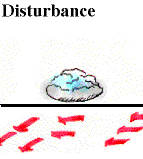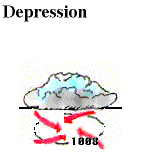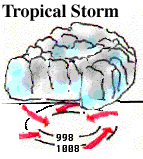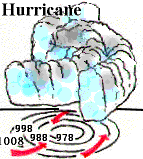
The word "hurricane" was first used to described any localized tropical cyclone in the West Indies. Derived from the Spanish word "huracan" which was most likely by Hunraken, the name for the ancient Mayam storm god or Hurakan, the Quiche god of thunder or any number of other Caribbean terms for evil spirits or big winds.
Ok now, i will briefly explain the process or stages of the occurrence of huriccane ..
For your information, the process begins in the warm, moist air over the waters of the region as the tropics which includes the Gulf of Mexico, the Caribbean Sea, the eastern North Pacific Ocean and the North Atlantic Ocean, east of the International Dateline and north of the equator. Tropical depressions, tropical storms, hurricanes and typhoons are all tropical cyclones and all may develop in the region.
Before it can become a hurricane, a tropical cyclone which is a low pressure system with a defined wind circulation that develops over the tropics. It must pass through four distinct stages which are:
Stage 1: Tropical Disturbance

A tropical disturbance is a discrete system of clouds, water and thunderstorms that originates in the tropics and remains intact for 24 hours or more. Tropical waves are a type of tropical disturbance that develops about every four to five days and some of these waves eventually strengthen to become tropical storms hurricanes. Sometimes it called easterly waves because they are the areas of low pressure that move generally from east to west embedded in the tropical easterly winds.
Stage 2: Tropical Depression

Second stage states that when a tropical disturbance develops a closed circulation for example counter clockwise winds blowing around a center of low pressure in the Northern Hemisphere, it is designated as a tropical depression. Tropical depressions contain maximum sustained one minute wind of 38 mph (33 knots) or less at an elevation of 10 meters.
Stage 3: Tropical Storm

At stage 3, a tropical storms have maximum sustained one minute winds of 39 - 73 (34 - 63 knots) at an elevation of 10 meters. If sustained wind speeds increase o at least 35 knots, a tropical depression is upgraded to a tropical storm. The surface wind speeds vary between 34 and 63 knots and the storm becomes more organized. The tropical storms resemble the appearance of hurricanes due to the intensified circulation.
Stage 3: Hurricane

At the last stage, as the surface pressures continue to drop, a tropical storm becomes a hurricane when sustained wind speeds exceed 64 knots. A pronounced rotation develops around the central core as spiral rain bands rotate around the eye of the storm. Winds in most hurricanes can become much stronger and can cause worst damages.

The picture shows the features of hurricane tightly formed and there is a visible eye at its center but not all hurricanes appear in the same way
So, do you understand about the process that i have explained ?? I hope you understand what we've been explained..
No comments :
Post a Comment